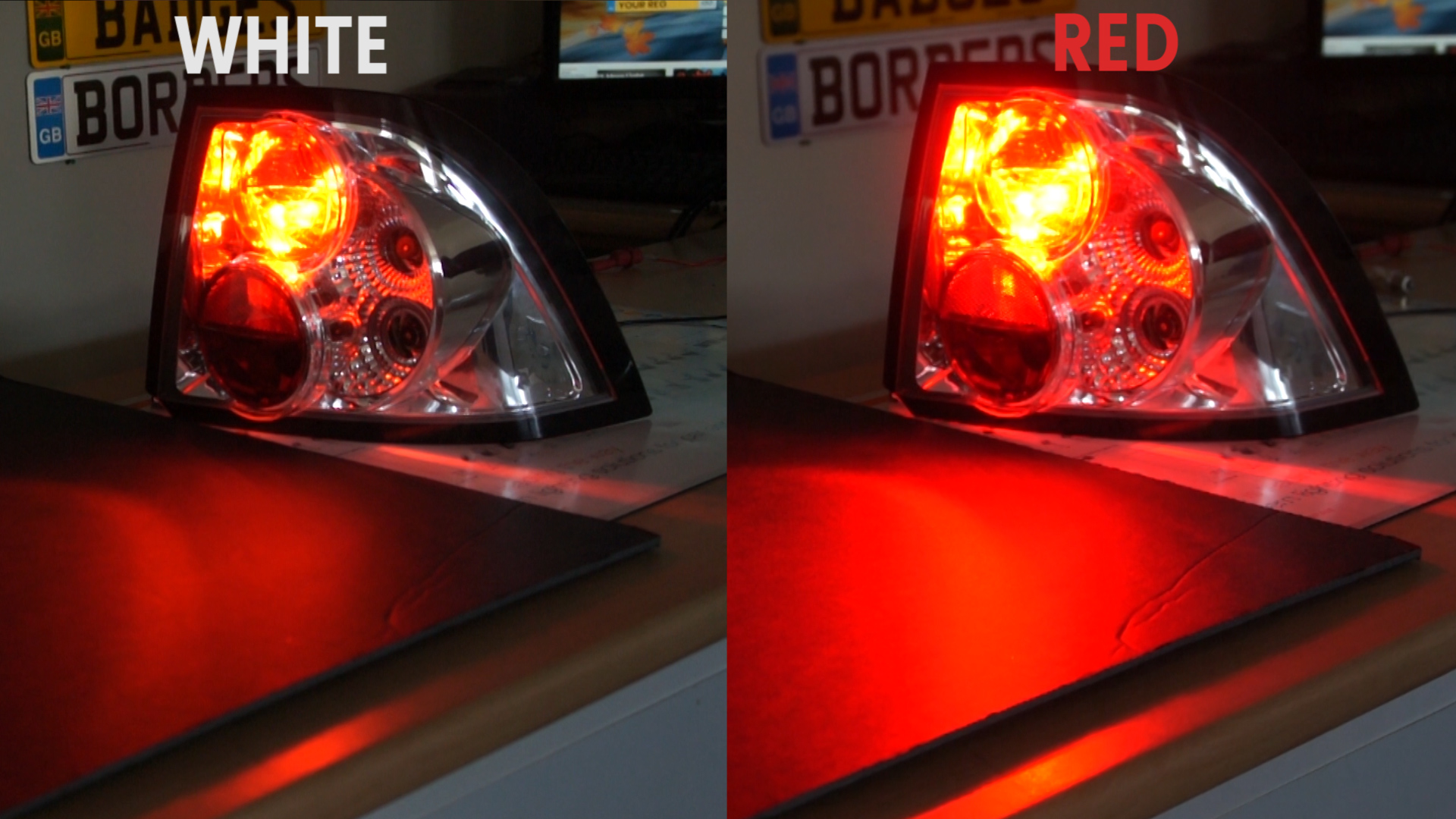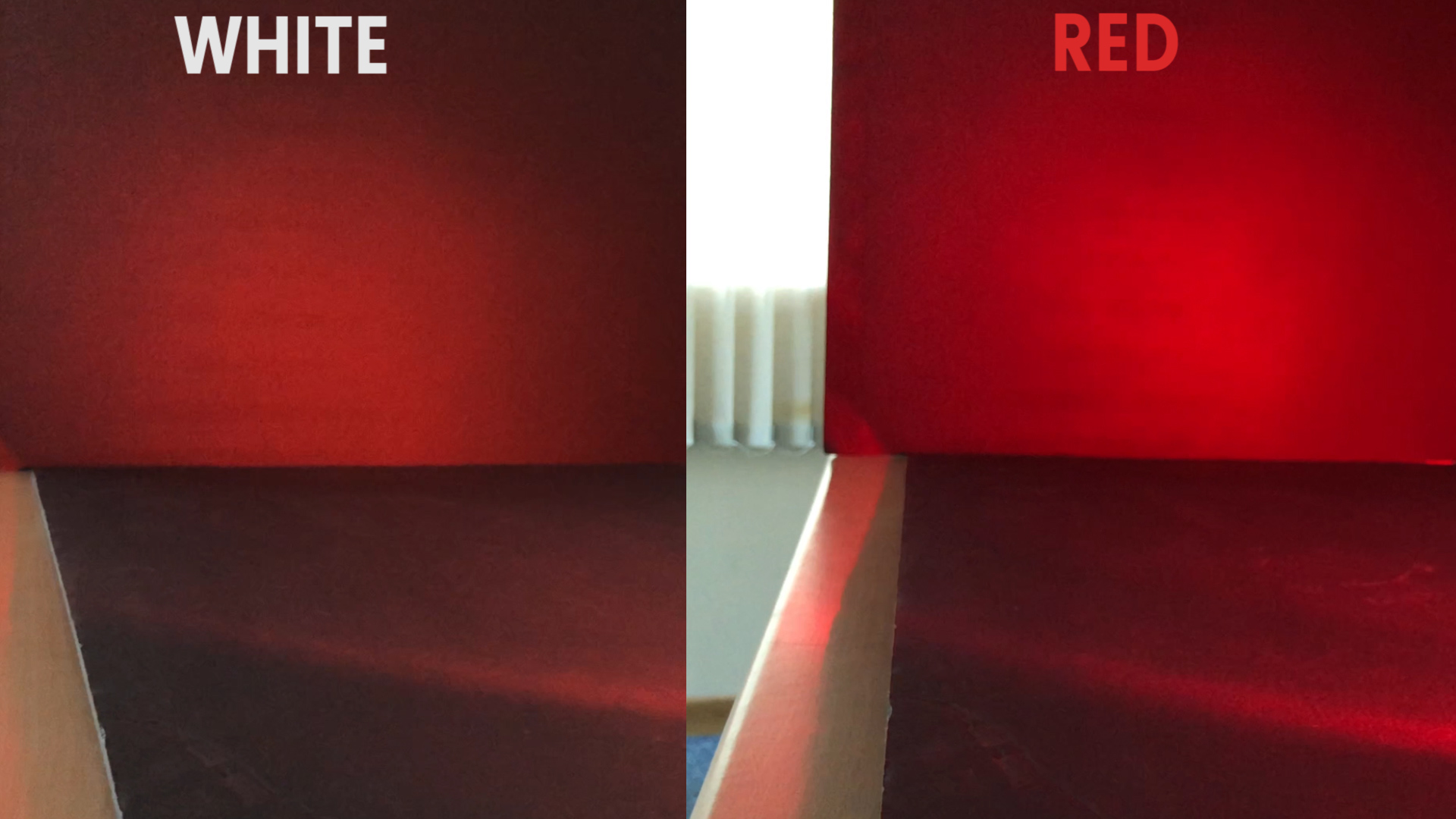Welcome to the next instalment of ABD TV where we aim to answer all of those burning questions, clear up the confusion and leave you brimming with knowledge.
Red or White LED Bulb?
In this episode we’re tackling a common question we get asked: Is a coloured LED bulb or a white LED bulb is better behind a coloured lens? This is a common issue with applications such as a brake light or indicator.
For some cars, the actual front or rear light units have clear lenses and the colour of the light is determined by the bulb. For example this amber 581 bulb for the indicators on this headlight unit:
However for others the colour is determined by the lens of the unit itself. As is the case on this rear cluster.
In these cases, the bulb behind the lens would be a standard white filament bulb such as this 382 bayonet bulb.
But what happens when you’re upgrading to an LED bulb?
The common sense reaction would be to swap like for like. If you have a clear lens with a coloured filament bulb, use a coloured LED. If you have a white/clear filament bulb behind a coloured lens, use a white LED. But is that actually the right thing to do?
The Test – Red Vs White
Obviously if you have clear lenses, you will have to use a coloured LED bulb so we’re not going to test out anything there. That’s just common sense. But let’s have a look at the difference between a white LED and a red LED behind a red lens.
The Brake Light
For this test, we are using the red and white versions of the Twenty20 Cree Canbus LEDs for brake lights. They are identical except for the colour so there’s no issue with mis-matching bulbs. The results you see are simply due to the difference of the colour.
As you can see from the pic, the red LED bulb is producing a much more intense and bright light. What is not so clear on the image is the difference in colour.
The white LED is producing a washed out red light, a kind of “light red”. It’s not as far as pink, although we have had some people report that to be the case, but it’s certainly a lesser red than you’d expect.
The red LED is producing a very intense and pure red light. Much better for this brake light application.
Those Pesky Misleading Lumens
Another important thing to note is that the white LED is rated at 750 lumens. The red LED bulb is rated at only 350 lumens. A lot of sellers out there use the lumen number as a marketing tool. Hey come buy this, it’s the brightest thing in the World and a million lumens! OK a bit of an exaggeration but you get the idea.
It’s not about the total lumen number, it’s about how usable that light is for the application that it’s being used for! You can see another example of this in our LED Headlight blog.
So let’s take a look at this from a different angle:
The Light Projection
Once again it’s clear to see which one is performing the best. The amount of red light hitting the board from the red LED bulb is far greater than the light from the white LED bulb.
So there you have it. When upgrading to LED, go with the colour that the application is for regardless of whether your standard bulb is white or coloured. This will give you the best and brightest results.
If you have any questions on this, feel free to ask them in the comments below.
Also if you have any other general product questions you’d like to see us cover in a future ABD TV episode, please send them in either via our social media accounts or via email.
UPDATE: A reader of ours suggested that amber lensed indicators, it is better to use the white LEDs as they come through brighter. We thought we’d put it to the test. Find out here if you should use Amber LEDs or White LEDs for indicators behind an orange lens –>
Author: ABD.co.uk





I noticed the white LEDs you tested are 6000k, I happen to know that LEDs (the typical ones you use, not high-CRI chips) emit a narrower spectrum of light than incandescents (the major reason they are more efficient, when efficiency is defined as light output/per watt, they both emit the same amount of total light per watt because physics but we can see almost all of the light from an LED).
So those 6000k LEDs are very heavily blocked by the red tinted lens because they produce almost no red, but warm white LEDs would not be. I only ever use warm white LEDs on the exterior of my vehicle (except off-road and reverse lights) because they look right.
Very good point.
To tie that back to the comment in the article about lumens – the 750 lumens is of emitted light of all colours, much of which is as you say blocked by the red lens. So perhaps 200 lumens gets through. While from the red bulb nearly all gets through, perhaps 300 lumens. Why does the lens allow through more red – why does it look red – because it blocks colours other than red.
That does prompt a question – are the red bulbs actually generating white light inside from red, green and blue LEDs, with a red filter, or are they actually using only red LEDs? The latter would be most efficient, but are bulb manufacturers and carmakers missing an opportunity to save energy?
Red LEDs only produce light in the red wavelength. There is no filter in the LEDs themselves.
Fortunately I came upon your website noting differences between Amber Led or white and Red led , and the correct choice to make.
I have a 2018 Mazda 3 Hatchback and decided to change quite a few standard Halogen bulbs for Led. I used a good quality Red T20 wedge with a projector type lens in the Brake/ Tail light assembly which was red. The results were as you showed, Deep red colour with excellent brightness, very visible. Next I use a similar projector LED ( Amber/Yellow ) in the clear glass unit for the Flasher/ Turn indicators. Also used 6 watt load resistors. Results again excellent, quick response and bright illumination, even in daylight. All worth while . Many thanks for your helpfull advice.
Very Helpful… I know that ‘white’ LEDs are calibrated in Kelvins as well as lumens. I have 6000k in my headlamps Dip & Full
What is the correct kelvin rating for ‘Amber’ bulbs? I have found that many LED ‘Amber’ units are very ‘Yellow’
i am using amber led bulbs as rear light and they work really good. I didnt have a change to compare than with white or red, but from my point of view, they do a far better job then regular halogens
What I would like to see on top of this is how to use the TYC rear tail lights in the UK. I’ve seen them but they have a red lens for the indicator where it has to be amber in the UK. I’ve seen an amber light behind it still doesn’t shine amber.
How do you fix this? I’ve heard green 582 7440 works behind it as green and red light make amber but would like to see if this is true and whether it is then road legal even though it’s a green bulb behind the red lens?
Any way you can show us all this in practise please?
Also heard of taking the lens out and making a new amber one with perspex? Any chance you can show that too?
Thanks.
Hi
I have a SEAT ALHAMBRA mk1 2003 1.9 TDI Deisel MPV CAR
I Have problems with changing the filament bulb to an led one
Because the led replacement for the red stop light causes the
Coil shap glow plug symbol to flash on instrument panel
Is there a canbus compatible red led stop light available to
Prevent this happening. Ie upgrade compatibility
Regards
Darryl
Very informative
All white LEDs, irrespective of stated colour temperature, are made from BLUE LEDs. If you look at their output spectrums, this is blatantly obvious. Put simply, use a red LED for stop/tails and an amber one for indicators. That way, a significantly larger percentage of the light produced will find it’s way through the lens (filter), giving a brighter signal for other drivers to see. Also, choose your LED replacement wisely, there is plenty of junk out there. Don’t forget to factor in a load resistor (if needed) for your indicators to prevent hyperflash, not to mention CANBUS issues.
What color LED bulb should I use in my harley tail/brake and license plate light?
I posted this also in comments for “amber or white LED behind Amber lens”.
You never comment,that the color of the white LED is 6000 K, and what happened if color of white LED is 3000 K (which is most similar with incandescent light) behind amber lens and behind red lens? In my experiments with 6000 K, the results are similar, but with 3000 K, lumens is what counts most.
Is it possible to have all clear or white rear lens with the appropriate coloured led behind? I know that 2 red reflectors must show but can everything else be white lens’d with coloured leds?